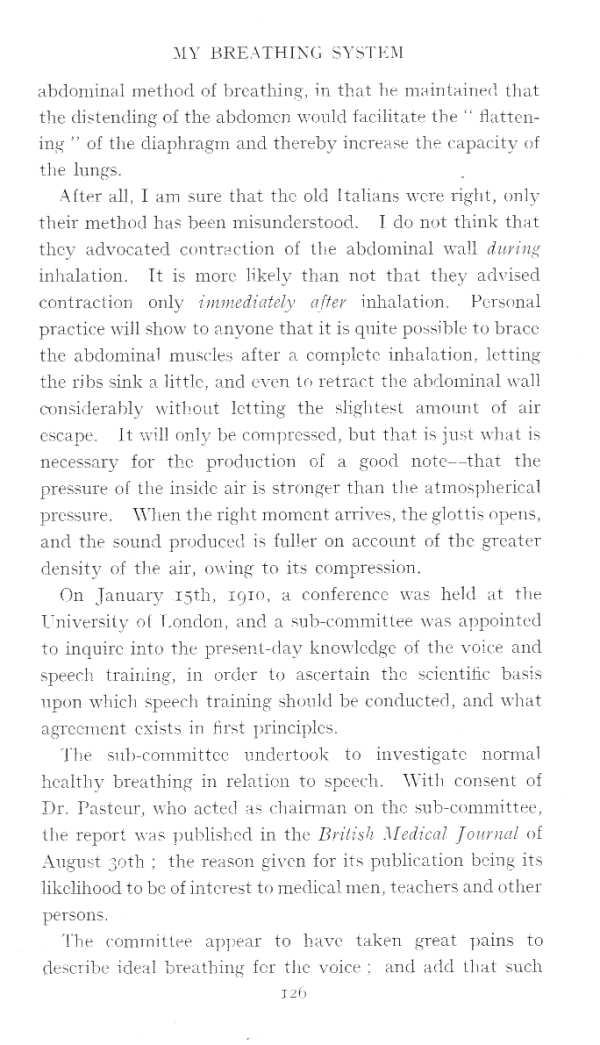40267 mbs 126

MY BREATHING SYS rKM
abdominal metliorl of breathing, in that he maintaitied that the distending of tlie abdomcn wonld facilitate the " Hattcn-ing ” of tbe diaphragm and thereby increase tbe capacity of the lungs.
A (ter all, i am surę that the old Italians were right, only their method has been misunderstood. I do not think that thcv advocated contraetion of the abdominal wali during inhalation. It is moro likely than not that they advised contraetion only i imnediately after inhalation. Pcrsonal practice will show to anyone that it is quite possible to bracc the abdominal muscles after a cornplcte inhalation. letting the ribs sink a littlc, and evcn to retract the abdominal wali considerably witb.out letting the slightest antount of air escape. It will only be compressed, but that is just what is necessary for the production of a good notę—that the ptessure of the insidc air is stronger than the atinospherical pressure. When the right moment arrives, the glottis opens. and the sound produced is fuller on accoimt of the greater density of the air, owing to its compression.
On January ijth, 1910, a conferencc was held at tlie l'niversity ol f.ondon, and a sub-committee was appointed to inquirc into the present-day knowlcdge of the voice and speech training, in order to ascertain the scicntilic basis npon which speech training should be eonducted, and what agreement exist> iti first priticiplcs.
I'he snb-committce undertook to investigatc normal hęalthy breathing in relation to speech. AYith consent of I)r. Pasteur, who acted as chairman on the sub-committee, the report was published in the British Medical Journal of August joth : the reason givcn for its publication bcing its likelihood to be of interest to medical men, teachers and other persons.
The comrnittee appear to have taken great pains to describe ideał breathing fer the voice : and add that such
jM>
Wyszukiwarka
Podobne podstrony:
mbs 063 MY BREATHING SYSTEM beginncrs to assist with the hands in the following manner : Takc tbem a
mbs 124 MY BREATHING SYSTEM be found invaluable froin the point of view of increasing the rangę of e
mbs 019 MY BREATHDfG SYSTEM exlialation than during inhalation. The lungs strongcr, it is an excelle
mbs 042 MY BREATHING SYSTEM the liarm done by such old habits that special excrcise of “ abdominal&q
mbs 062 MY BREATHING SYSTEM inhalation, as a part of " my complete breath,” no attention should
mbs 065 MY BREATH ING SYSTEM exhalation comprise, each of them. two abdominal move-ments—four in all
70195 mbs 102 MY BREATHING SYSTEM EXERCISE No. 9. Special abdominal breathing, combined with movemen
mbs 078 MY BREATHING SYSTEM conspicuously-knotted abdominal muscles believe, and make otliers believ
więcej podobnych podstron